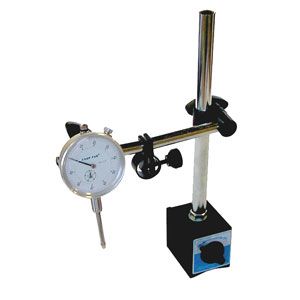Q&A
Question:
I purchased one of your
magnetic dial indicators
but there were no directions included. It looks
complicated. How am I supposed to use this thing?
 Answer:
Answer:
That is indeed a reasonable question to ask! We checked with our supplier and found they were unable to
help us out with instructions. In fact, they do not have any instructions at all!
That said, I think we can provide you with enough information to allow you to use the instrument successfully.
The photo at right illustrates how the the dial portion of the unit is
attached. The position on the main vertical shaft can be adjusted by loosening the black knob and
raising or lowering the dial unit to the desired height. As you probably have discovered, the
dial head can also be be positioned through a wide range of angles. The smallest knob is the fine
adjustment knob.
So, how is this thing used? The easiest example will be measuring the thickness (or variation in
height) of a horizontal surface. Place the unit on a table with the base down. Loosen the knob
closest to the vertical shaft. This will allow the arm with the dial to move up and down the shaft as
well as along a plane from straight up to straight down. In our case, we want the rod holding the
dial to be perpendicular to the table surface. Lower the shaft until the point is just touching the
table. You may or may not need to use the fine height adjustment function. Zero out the dial using
the moveable ring on the outside of the dial. Now slide something like a piece of paper between the
dial pointer and the table. The needle will move from zero to whatever the thickness of the
paper is.
That example should already give you enough know-how to check, for instance, the amount of wobble (known as run out) there is in a table saw blade
measured over the course of one full revolution of the blade. Begin by raising the saw blade to full height.
Place the dial pointer against the side of the blade. You may have to reposition the angle of the
short arm. Zero it out like before. Turn the blade with your hand and if there is any run out in
the blade the dial will let you know how much.
You can also apply this general approach to measuring the run out on a drill press or the height along the
knives of your jointer.
Hopefully this explanation has helped and that you will be able to use the tool to your
satisfaction.
Return to
Wood News
front page